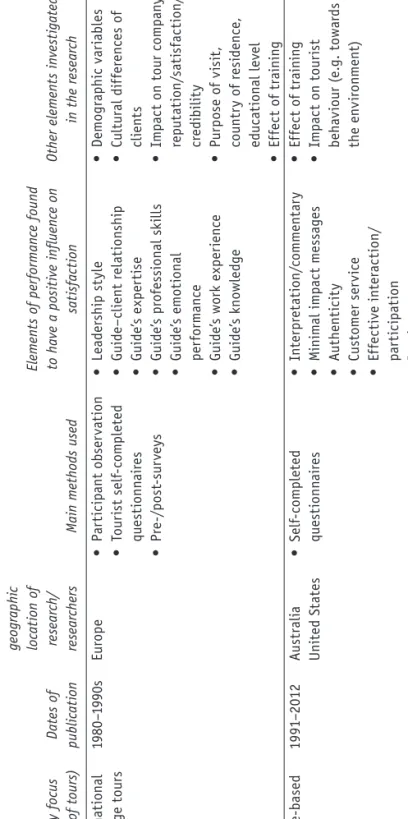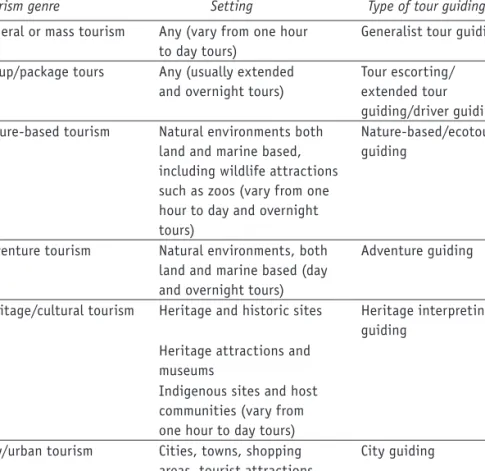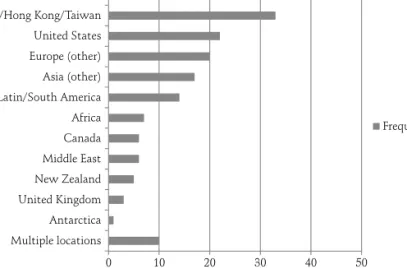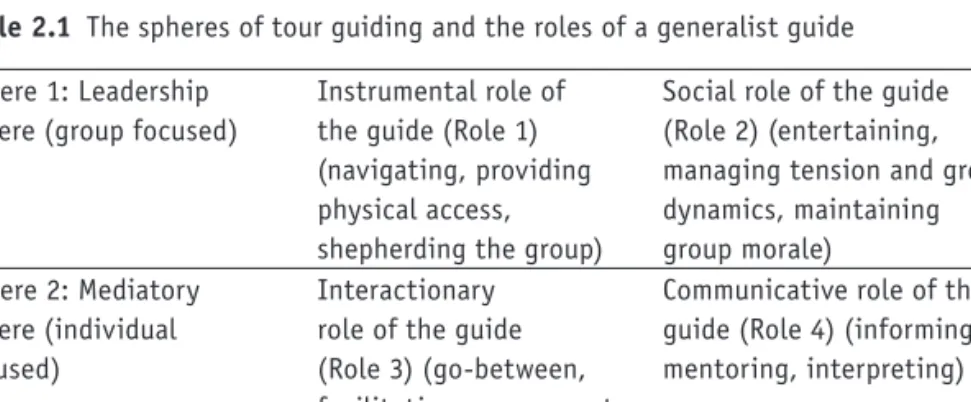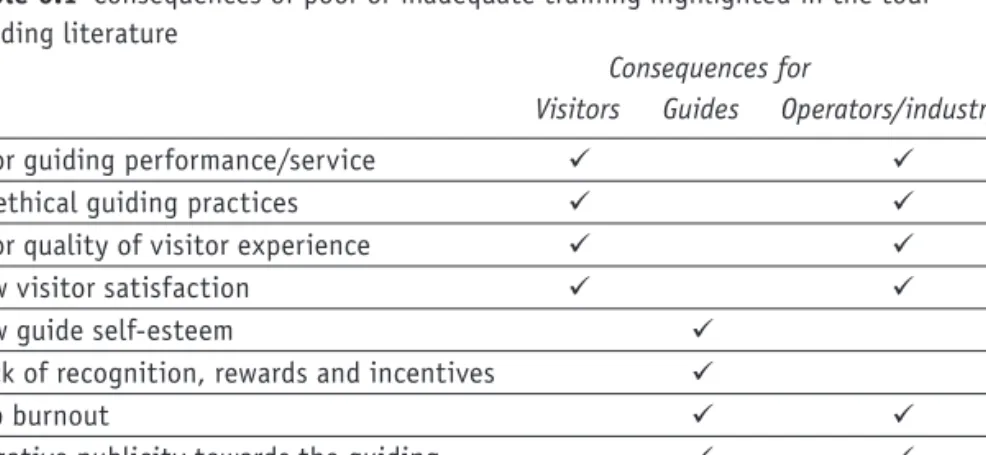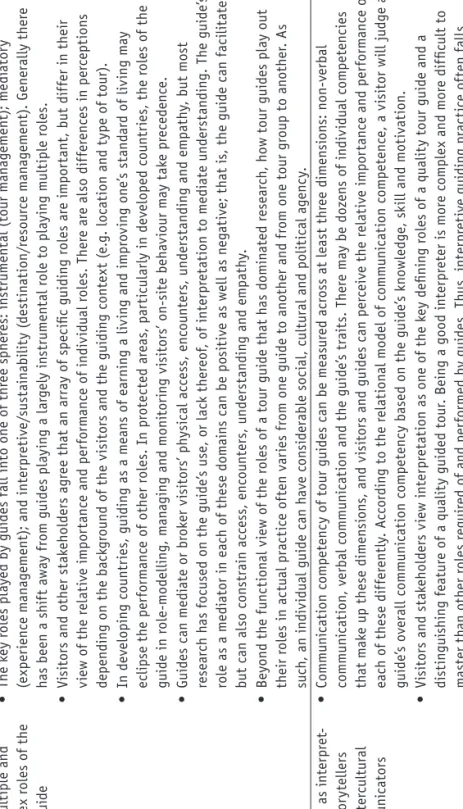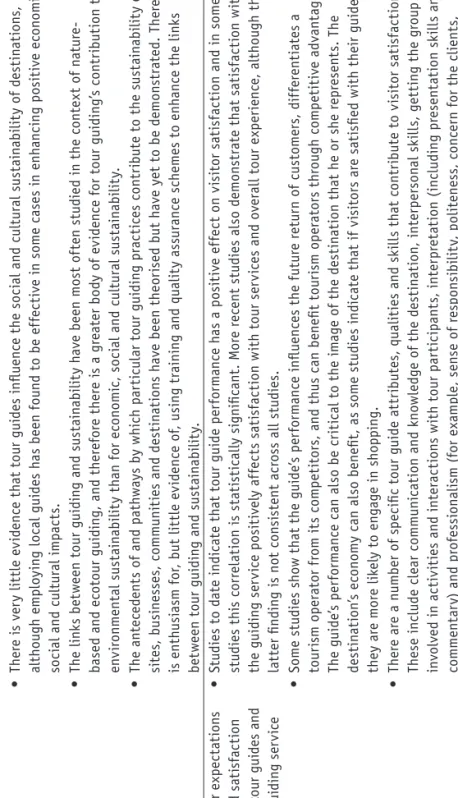A more nuanced examination of the geographical distribution of research on tour guiding is provided in the individual chapters of this book. One of the earliest published papers in the field of tour guiding is Cohen's (1985) sociological perspective on the mutual relationships between the guide and tour participants. Social role of the guide (Role 2) (entertaining, managing tension and group dynamics, maintaining group morale).
Interactional role of the guide (Role 3) (intermediary, facilitating engagement with local residents and local services). However, most of the authors of these studies admit that 'the number [and relative importance].

Mediating/brokering physical access
Here it is worth making the distinction noted in Chapter 1 between mediation and interpretation; that is, that "interpretation" is both a role in itself and a collection of techniques for mediation, specifically to help visitors understand and empathize with objects, persons, places, or environments. As will be seen in the next section, much of the research on mediation has been on the use or non-use of communication, especially interpretation, in order to facilitate understanding. The strategic use of tour guides to influence on-site behavior and change post-visit attitudes and behaviors can also be considered mediation; however, these are considered separately in Chapter 4.
Mediating/brokering encounters
Mediating/brokering understanding
The cultural mediating role of the guides revolved mainly around the communication and interpretation of local cultural values, both those of the area and those of Aboriginal society in general. Indigenous guides play a mediating role by communicating and interpreting the local cultural values of the country and Aboriginal society in general. Thus, the guides' performances were staged and routinized, limiting and negatively mediating understanding.
Mediating/brokering empathy
A final example of the negative mediation of understanding is McGrath's (2007) critique of the management of archaeological sites in Peru. Almost everyone who researches and writes about tour guides and management emphasizes the importance of the communicative role of the guide. A review of a few studies that examined the communication skills of tour guides in a broader sense is included.
Leclerc and Martin (2004) did not report the importance of each of the tour guide communication dimensions in relation to the other dimensions and few other studies have examined the communication competence of tour guides. This part of the chapter revisits and expands on the definition of interpretation presented in Chapter 2. Some of the earliest mentions of interpretation in the context of tour guiding are by anthropologists and sociologists such as Almagor (1985), Bowman (1992) and of course Cohen (1985), who used the term to denote the mediating role of the guide.
Research on intercultural communication in the context of guided tours points to a range of communication competencies required of the guide (see Table 3.2). Thus, interpretive guide practice often falls short of the expectations of visitors and other stakeholders. Such a conservative and narrow conceptualization of the links between tourism and sustainability is, unfortunately, all too common.
This chapter seeks to expand the conceptualization of the potential and actual contributions of guiding practice.
Enhancing understanding and valuing
Interpretive guides can have an impact on visitors' understanding of and engagement with heritage, and on their attitudes towards heritage conservation. More direct and observable measures of understanding, beyond the overly simplistic 'factual recall' that dominated earlier interpretation research, and measures of visitors' appreciation of nature and heritage, are needed to determine the real impact of interpretive guidance. Jensen further argued that as a result of serving as guides, the interviewees gained the trust of the village chief and local residents, which in turn made the guides more motivated and empowered to practice ST themselves.
Pereira and Mykletun comment on the potential role of guides in 'engendering an appreciation for local products' and helping local artisans produce goods that meet visitors' expectations. This qualitative study in Banff National Park (Canada) included participant observation of the same guided hike on six separate occasions along with interviews with several of the participants, park staff and other stakeholders. The environmental messages of the guide were well received by tourists who described the content of the tour with 'awe, respect and gratitude for the work being done' (Henning.
By explaining to local residents [that] tourists come to 'see nature' and the potential [environmental] benefits of visitors [through a weekly one-hour radio program], guides also play an important role in the success of ecotourism by promoting conservation... Guides also play an essential role in connecting with people in the villages and directing tourists' money to the peripheral areas of the park. Finally, Poudel and Nyaupane (2013) undertook a comparison of the self-reported attitudes and behaviors of 230 visitors on guided and unguided tours in the Annapurna region of Nepal. Interestingly, while the attitudes and behaviors of visitors on guided tours differed significantly from those on unguided tours on most items on both scales, visitors on unguided tours actually scored more positively on some items, particularly behavioral items.
Of course, visitors were not randomly assigned to guided versus unguided tours, so this result may simply reflect prior differences between these two groups of visitors.
Infl uencing and monitoring behaviour
By comparing tourist behavior and resident responses in the two case studies, the researcher concluded that a high level of tourist compliance and a low level of negative (as well as unexpected positive) sociocultural impacts were due to the presence and actions of the guides. . They found that the tour guide's group management skills and knowledge level greatly influenced the visitor's behavior and potential impacts on the environmental and cultural sites and visitor satisfaction. Nature-based guides communicate messages about appropriate behavior and monitor on-site behavior and its impact on wildlife and habitats.
Participant observation and audio recording of guide commentary on 20 guided tours found that 17 of the guides delivered 107 messages related to Parks Victoria's objectives. Randall and Rollins' (2009) study of kayak tour guides in a marine national park in Canada found that visitors perceived guides to perform poorly in communicating environmentally and culturally responsible behavior compared to what they expected. Finally, in their study of 36 tour guides in the Brazilian Amazon, Pereira and Mykletun (2012) found little evidence of guides communicating environmentally responsible messages or acting as cultural brokers.
These studies are based on evaluating what the guide says or does, or in some cases, how visitors perceive it, rather than assessing the actual behavioral responses of visitors on site. In recent years, a number of studies have evaluated communication interventions designed specifically to promote responsible on-site behavior. Indeed, several studies have shown the successful effects of tourism management in reducing the level of non-compliant and illegal on-site behavior that was unintended (e.g. off-trail hiking, wildlife feeding and littering) (Howard et al., 2001; Littlefair, 2003; Orams & Hill, .
A more complex research question is the transition from measuring on-site visitor behavior to assessing the impacts or consequences of on-site visitors' actions or inactions on sustainability, as impacts can be cumulative and long-term. 2007), but through observation and comparisons with a control group that was not guided, they were able to conclude that the presence of a guide during land-based seal watching programs and seal swimming programs had a significant effect on reducing both non-compliant tourist behavior and seal avoidance.
Fostering post-visit attitudes and behaviours
The purpose of this chapter is to provide an overview of the research on how tour guide performance is affected by visitor satisfaction as perceived by visitors (including tourists), guides and operators. A number of recent studies of tour guide performance have used specific frameworks or models. This supports previous research that tour guide performance in tourist purchasing is one of the key factors that stimulate purchase intention (Tosun et al., 2007).
The implications of these study findings are important for the tourism industry, so the role of the tour guide should be recognized and rewarded accordingly. Intensive tour guide training in regional Australia: An analysis of Savannah Guides and professional development schools. He argues that in the context of the guide industry, especially in the management of ecotours, the terms.
Based on previous work (Black & Weiler, 2005), this chapter outlines the advantages and disadvantages of, and builds on, previous research to consider the potential of a number of quality assurance mechanisms to achieve three outcomes: (i) increasing awareness and appreciation of the. However, one of the challenges in developing a certification program is the diversity of tour leaders and the different roles they have to fulfill. Critical issues affecting the service quality and professionalism of the guides in Hong Kong and Macau.
This is followed by implications for tour guiding practice that the present authors have identified from their analysis of the research findings. Tour guiding in the context of the polar regions, rural areas and marine, coastal and inland waterways is also largely under-researched. Other authors have examined the issue of the personal well-being of tour guides from a range of perspectives.
Raising awareness among private citizens, the public and the government at local and national level about the importance of the role of a guide. These organizations are at the heart of the industry network and are involved in issues such as the development of standards and training for tour guides and interpretation.
